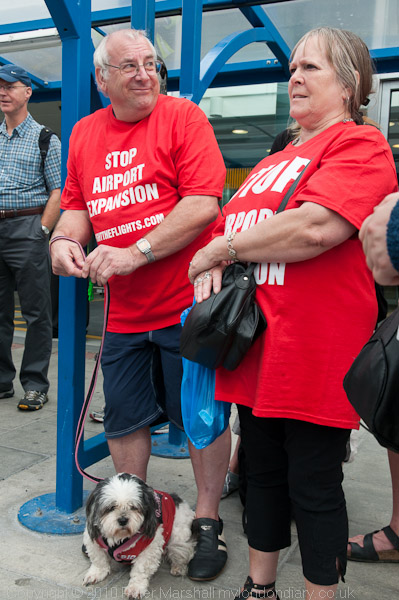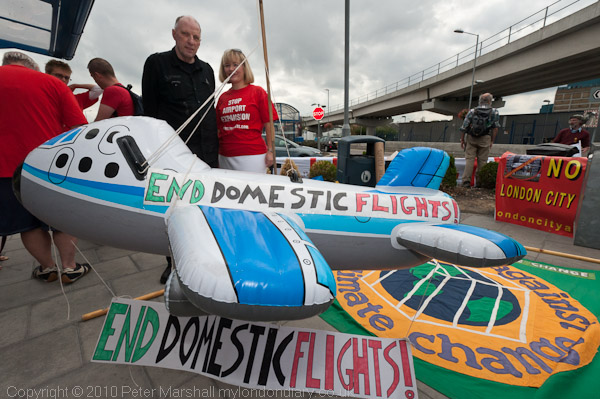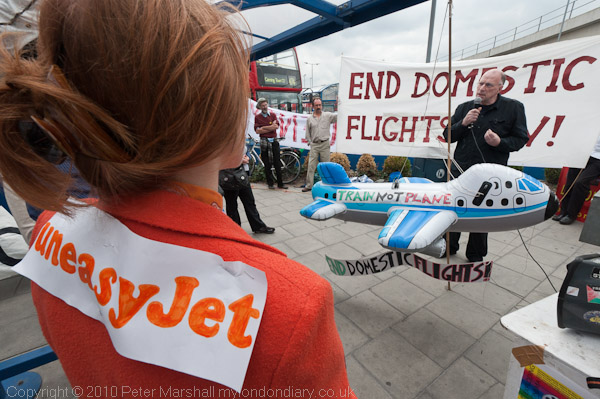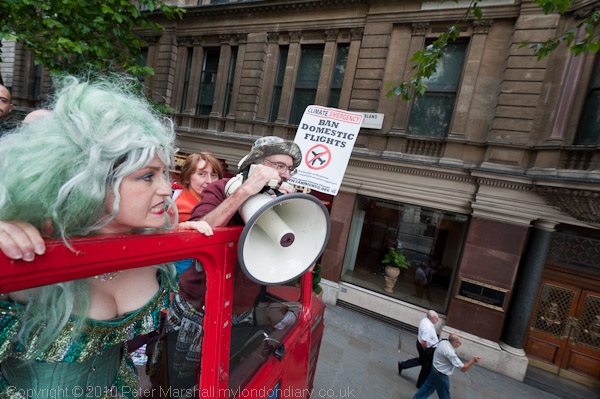Years ago when I was photographing London’s Docklands I needed to get a picture with a plane taking off from London City Airport. The first time I wasn’t quite happy with what I’d got and I had to wait almost an hour for the next aircraft to appear.
London City got planning permission because they promised to have only a very limited number of flights and to use small quiet turbo-props that would take off at a steep angle and thus cause very little noise. How things have changed. Over 90% of the flights now are by noisy jets leaving the airport at lower altitudes and they already have plans to expand to 176,000 flights a year – almost 500 a day. Had levels of this kind (or the current level) been stated at the initial planning inquiry their would have been little chance of the airport being built in what is one of the most densely populated areas of the country.

Local residents in Fight The Flights oppose airport expansion
It’s become a favourite place for the wealthy owners of private jets, as well as running scheduled services but is now aiming at a much larger market. It started very much as a premium service for rich businessmen who could avoid the lengthy delays at normal airports; your taxi from your city office could drop you at the airport door ten minutes before take-off and you could rush through the lounge passport in one hand, briefcase in the other and still catch your plane. Now you can get there on the DLR and need to allow a little more time as increased security and larger passenger numbers slow things down a little. But check in times still seem to be in minutes rather than the hours at Heathrow and Gatwick, so it’s perhaps not surprising it is getting popular.
Which is bad news for local residents – and the reason for their protest group ‘Fight the Flights‘ which is mounting a legal challenge against Newham Council’s approval of a rise in flights from 91,000 to 120,000 annually in the High Court this November.
The airport was set up for short haul flights, mainly to continental cities, but now serves a wider range of destinations including New York (check in time for BA customers with hand luggage is 15 minutes!) But the most contentious of these are domestic flights such as the services to Manchester from here and the other London airports – currently 38 flights a day.
From central London to central Manchester by train takes around 2 hours 7 minutes – and there is a train every 20 minutes during much of the day. The flight from either Gatwick or Heathrow – including checking – takes from 10 to 20 minutes longer, and the journey times from the airport at both ends are likely to add considerably more. Even with flights to Glasgow, the train journey of 4 h9m compares pretty well with the flight time from London City – including minimum check-in and exit times – of 2 h35m when you include the travel times to and from the airport.
But Saturday’s demonstration was not about convenience but about climate change. A typical rail journey from London to Manchester results in 15.9kg carbon dioxide per person, while the flight produces 52.8 kg – more than three times as much. Add in the amounts for the journeys to and from the airport and the difference is even greater.
We don’t need short domestic flights, the noise and hydrocarbon and other pollution they cause around the airports (air pollution around where I live near Heathrow is often above the accepted limits for various pollutants) both blights and shortens our lives. But man-made climate change has far more serious effects on the poor around the world through the destabilisation of climate that is already becoming evident through the increasing incidence of droughts, floods and hurricanes and rising sea levels. It is also the poor who are most threatened by the aviation industry’s attempts to move to using agrofuels. Almost all biofuel production is at the expense of the environment, clearing forests to grow fuel crops such as palm oil, or diverting land that was previously in use for food production, accelerating the rises in food prices, so that the poor starve.
The Campaign Against Climate Change demonstration wasn’t a large event, but the issues it raises are vital ones. Aviation is the fastest-growing source of greenhouse gases and it’s thus important that the richer countries such as ours tackle it and find ways to slow and eventually reverse its expansion.

John Stewart of HACAN and Anne-Marie Griffin, chair of Fight the Flights
with campaign plane and banners
Photographically I couldn’t find a great deal to do, though the protesters did have an inflatable jet with some suitable slogans, and there was someone dressed as an air hostess with a label on her back ‘UneasyJet’. And of course the people involved.

Later my favourite mermaid appeared too. But I wanted to photograph her along with Phil Thornhill of Campaign Against Climate Change standing at the front of the top deck of the open top bus as it made its way towards Trafalgar Square. Easy enough to organise if I had time and money, but not when you get the idea and want to do it straight away.
One thing I often mean to bring with me but usually forget (it doesn’t quite fit in my camera bag) is a monopod. Given that and a remote release (which I don’t own) it would have been fairly easy. But I had to do with leaning backwards over the front rail of the bus, holding the D700. I took a few holding the camera at arms length, though it was hard to get the right angle. All the time I had to work with one arm, holding on tight with the other as the bus was bumping along the road.

You can see more pictures – and more about the demonstration – on My London Diary.